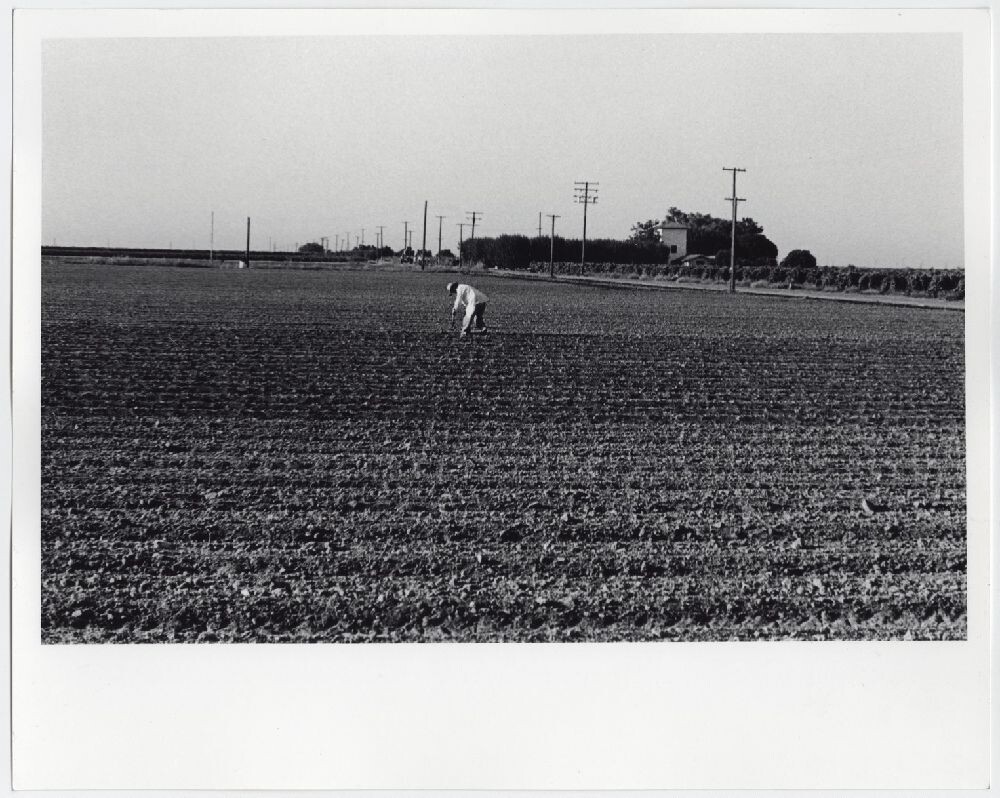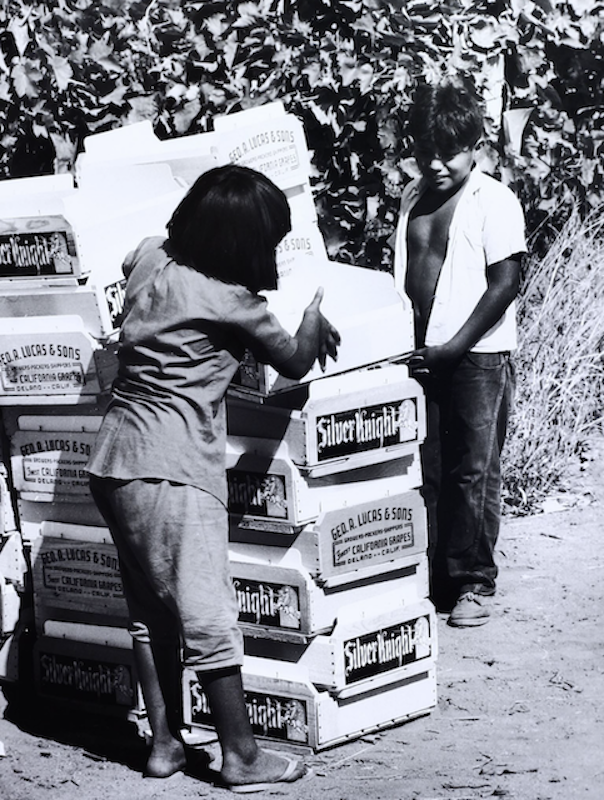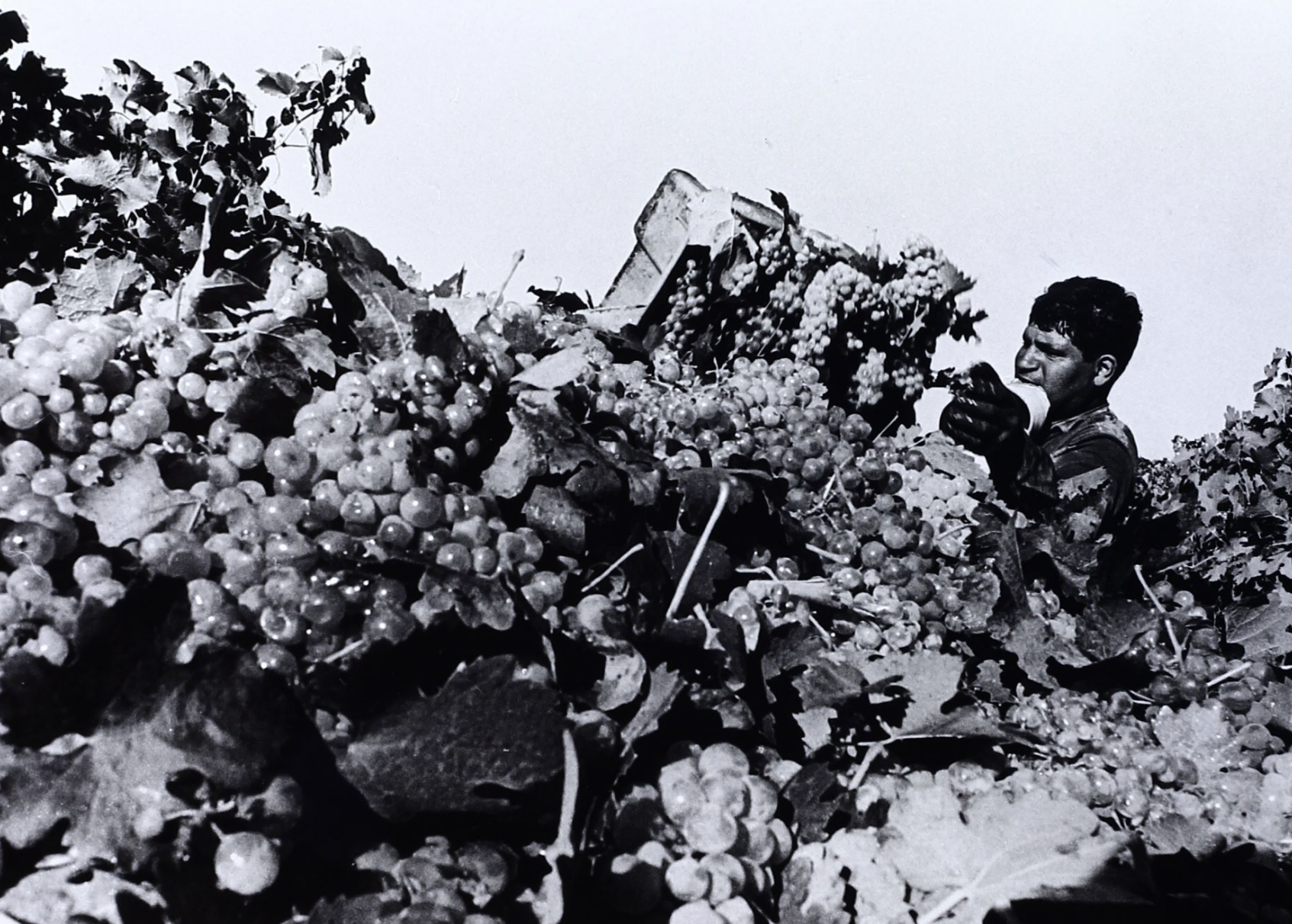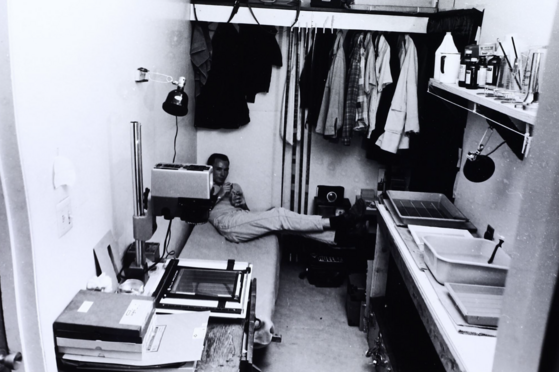
After serving in the United States Marine Corps, freelance photographer and printer from San Francisco Jon Lewis joined the budding United Farm Workers movement and its determined leader Cesar Chavez and other Chicano activist, Dolores Huerta. Using nonviolent organizing tactics steeped in Chicano identity and civil rights rhetoric, Chavez and Huerta defended the rights of farm workers, popularizing the name “La Huelga,” which has become synonymous with the Chicano farm workers’ community.

“We were working for the days our daughters would not be at our sides in these fields… and the sons of our sons would be as men of the land”
-From this Earth, of the Delano Grape Strike, Jon Lewis

California’s agriculture has heavily relied on a farm production system that employed low-wage laborers from minority communities. Western farm workers became largely Mexican as a result of the exploitative “Bracero scheme,” which was developed to undercut domestic wages by bringing in thousands of Mexican employees. Many workers were subjected to a variety of abuses while working in the fields, including exposure to hazardous chemicals, insufficient food and shelter, low earnings, and, most severely, no benefits. Migrant laborers were forced to work in deplorable conditions, and when they sought better treatment, they were met with prejudice and brutality, and attempts to create a union were violently suppressed.
1965-1970
Filipino farm workers in the Agricultural Workers Organizing Committee called for a strike against more than 30 grape growers in Delano, protesting years of low pay and working conditions. The Agricultural Workers Organizing Committee urged the National Farm Workers Association, a predominantly Latino Farm workers organization led by its leader, Cesar Chavez. Being a child of farm workers Chavez knew of the fields, he talked to others about how things would get better and many thought he dreamed big however, he said it had to start somewhere. Little by little things started happening. A year later a major collaboration was formed with the Filipino farm workers, Chavez led their cause and formed the United Farm Workers Organizing Committee. A first step toward accomplishing their dreams.
“ The growers and their armed guards couldn’t scare us. They were there with their shotguns and their dogs, they shoved us and hit us and called us every name- but we were nonviolent and we kept on and were not silenced”
- From this Earth, of the Delano Grape Strike, Jon Lewis
They started, with long days on picket lines ahead of them. Threats were made, they were sprayed with sulfur, covered in dust and arrested. They persisted, nonetheless, day after day, and eventually for years. Their voices were heard. They spoke with the farm workers around them, and many respected and understood their reasons for picketing. Many workers started to walk off the fields and join the picket lines, many of whom were migrant workers who were driven hundreds of miles from their homes to work on the field. They carried their luggage and their pride as they walked to join the movement. The dream of becoming a union was coming together and stronger than ever: as they wished for no farm workers to stand in the sweltering sun covered in sand with their belongings in their hands ever again.
All around the country, the call for “Huelga” could be heard. Donations began to pour in, and Robert Kennedy and Martin Luther King Jr stood with them. The United Farm Workers began calling for more boycotts around the country, providing volunteers with any money they could spare and assigning them a city to assemble picket lines, and they heard “Huelga” everywhere. From Chicago to Boston, the picket lines had grown.
Winter had arrived in California, and the fields were beginning to become empty, significantly slowing things down. Cesar Chavez, on the other hand, had a vision that he carried with him throughout the fields; he organized a group of volunteers to walk three hundred miles to Sacramento, the state capital, and they set out. Then, three days before the march, a grape grower, the Schenley, recognized their union and signed a contract; as a result, their march expanded in size, and three weeks later, they arrived at the capital with 10,000 people behind.
Chavez and his persistent leadership intensified in the decades that followed, and he continued to lead the United Farm Workers, using nonviolent methods to rally support for farm laborers in their efforts to stand up for their rights across the nation. United Farm Workers members continued to hold their banners displaying an eagle with the term “Huelga” in towns across the country, urging the states to introduce legislation that would allow farm workers to form a union as well as to highlight the importance and humanity of all agriculture workers.
A protest that began in Delano’s fields grew into a statewide boycott that attracted nationwide support. By 1970, the United Farm Workers grape boycott had been a success, and grape growers in Delano had signed their first-ever union contracts, guaranteeing increased pay, benefits, and rights for their workers. A year later, Chavez pledged to build their headquarters; main offices of their union, a clinic, a store, and their meeting hall on the land where their union started.
Note:
Cesar Chavez fought endlessly to achieve better pay and safer working conditions for farm workers and his impact in the farm workers and Mexican-American community will never be forgotten. However, Cesar Chavez has a complex history within the Chicano community, holding controversial stances in immigration. When discussing Chavez’s accomplishments and legacy it is vital that we recognize his problematic viewpoints and take that into full consideration when acknowledging his influence.
An Analysis of the Collection
What Lewis was able to capture in the California fields was powerful. Jon Lewis’s talent for noting the irony, juxtaposition, and framing and shooting it evoked emotion. He used the workers, the shadows, the lighting, the age, and nature itself to amplify the emotions in the photography.

Farmworkers believed in the cause and joined it. In this photograph, you see their faces, the flags, and the nature surrounding them. Lewis captured the image and used the dark tones on the flag and the faces to depict the fear and uncertainty that the movement had. Farm workers took risks in protesting, risking their jobs and income. Nonetheless, they pursued to achieve their mission. As they march, the light tones reflecting off the grass enhance the strength the workers held with them in the movement. As they march they are illuminating the path to the finish line. Lewis used this angle to highlight the resilience the workers carried with them as they pushed in the fields and to the end.

Through his collection, Jon Lewis perfected the art of illustrating irony. The women in this photograph are putting in a significant effort in gathering grapes. They dress in protective clothing, collect the grapes, measure them, sort them, and afterward package them into boxes. They are the backbone of the American agriculture industry providing food for millions every day. Yet, because of their extremely low earnings, these same women are often unable to put food on the table for themselves and their families. As I was looking through the collection, I noticed irony was a prominent key point in several of these photographs. From the lighting, the nature, the clothing, and the age of the workers, the ironic message was brilliantly demonstrated by Jon Lewis.

Many of the images in the series feature prominent use of facial expressions. Workers of all ages, including young children, can be seen taking part in the movement: harvesting and picketing. In this photo, two adults are gazing at the vacant field, the woman holding a child in her hand. Children were often working in the field with their parents. Helping their families financially to supply income for their household. Yet, this often endangered their health and wellbeing. The parent’s wish to end their child’s cycle of farm labor is powerfully captured in this specific photograph. Lewis made use of the child’s perspective and angle to underline his point.
Jon Lewis Photographs from The United Farm Workers Movement, A Look Into “From This Earth” and More
Jon Lewis was able to self-publish 500 copies of his photographic book “From This Earth” using the documentation he obtained during the campaign. The collection combines outstanding poetry and photographs, ranging from prints to presswork. With “From this Earth” Lewis sought to tell the story of the Delano Grape Strike through the perspective of Chicano workers, using photographs that fiercely encapsulated the Delano Grape Strike’s vision, language, and mission.
In addition to fighting for labor rights, “La Huelga” was also a civil and social liberation movement. Lewis was able to portray not only the perilous conditions of farm workers but also the birth of a person and their identity in central California’s valleys, fields, and streets his visuals are relics of photography’s vital significance in the struggle for social development and human rights, as they are intense, powerful, and intimate, conveying the long-lasting efforts of the fight for labor rights. As an organizing tool for the United Farmworkers, Lewis was also able to produce a film in Spanish, “Nosotros Venceremos,” made from still photographs. From beginning to end, the filmmaker blends his stills with the sounds of the movement and photographs he has captured; the marches, the boycotts, to the union label on the grape box, With the power of his lens, Lewis was able to capture a magnificent piece of Chicano history.
Today
Today, the United Farm Workers continue to advocate for legislative changes for the farm worker community, as well as employment safeguards and immigration reform; Years of political rhetoric and legislative changes have continued to make immigrant workers vulnerable and excluded. Farm workers labor conditions are becoming increasingly more difficult as temperature increases, and they are susceptible to multiple heat and smoke-related conditions. Despite this, workers must continue to report to the fields since they cannot afford to lose any income.
“ We looked at each other and knew from our eyes and how we stood that we were the ones we had lasted and out union would live”
- From this Earth, of the Delano Grape Strike, Jon Lewis
I had a great chance to explore the collection while curating this article. After spending more than a month going through the documentation—photographs, films, audiovisuals, writings, and more—I discovered that Jon Lewis, unfortunately, passed away in 2009. Lewis was one of a select group of photographers who committed himself to document the lives and mission of the farm workers in the early years of the movement and I wanted to compose a blog post that recognized Lewis’s talent and his impact. I also felt it was equally important to highlight the struggles of the workers; as they are still facing challenges today. Farm workers are consistently resilient, enduring hard labor, poverty, discrimination, and health concerns while being the foundation of our country’s food security, feeding millions of Americans every day.



